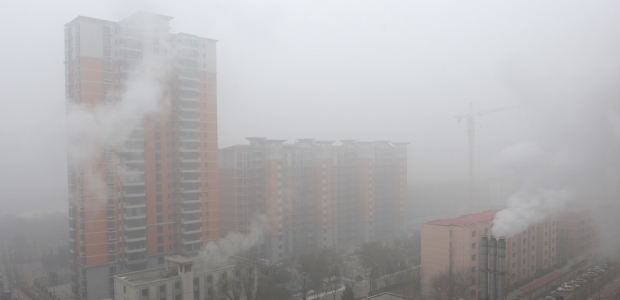
China Regulates CO2 Emissions
Will China's public pledge to mitigate environmental issues and adopt meaningful greenhouse gas controls take hold, or will political obstacles and rapid growth get in the way?
- By William Schulte, Adam Moser, Phoebe Youhanna
- Jan 13, 2014
In mid-November, the top echelons of China's leadership met for the 3rd Plenum of the 18th Communist Party of China Central Committee and introduced broad economic reforms that could have major impacts on China's goal to drastically reduce CO2 emissions per unit of GDP. In light of China's overall economic expansion and the complexity of the country's fuels market, it is difficult to predict which way these reforms will go but easy to understand that the stakes are high.
China emits more greenhouse gases than any other nation. China's per capita emissions are now higher than the global average and equal to or higher than some European countries. China burns nearly half of all the coal burnt globally and has the world's largest automobile market. All of these factors contribute to air pollution events worthy of international headlines. Additionally, China's relative lack of fresh water increases China's vulnerability to the impacts of climate change, as recent droughts have shown.
When it adopted its 12th Five-Year Plan in March 2011 (covering 2011-2015), China signaled that addressing climate change would be a top priority. While China has so far resisted adopting an absolute cap on greenhouse gas emissions, the plan set ambitious targets for reducing both energy intensity and CO2 emissions per unit of GDP by 2015 and for increasing the share of non-fossil fuel energy. Preliminary statistics show that the country is on track to meet some of these targets. Subsequent supplementary plans set goals for raising energy efficiency and capping energy and electricity consumption.
A key issue to watch will be the contributions of the 3rd Plenum reforms to these goals. For example, China's current model for dispatching electricity from generation facilities, particularly coal power, is wasteful and should be adjusted so that the plants first deployed are the most economically and environmentally efficient. A more rational pricing method for fossil fuels consumption and more rigorous enforcement of environmental regulations would also help to utilize existing facilities more efficiently, and should be pursued aggressively.
China's building sector, which at present is wasteful and inefficient, also needs reform. China is aiming to move 300 to 400 million people from rural to urban areas over the next 17 years, building an estimated 1,000 new cities to house them. Market incentives should be implemented to ensure that the millions of new buildings being built will be efficient and useful 30 years from now.
Further, as standards of living and incomes rise and China moves away from its heavy export dependency and toward increased domestic consumption, its appetite for energy and the resulting CO2 emissions will continue to rise. Though the 12th FYP aimed to cap GDP growth at 7 percent, China exceeded that rate in 2011 and 2012 and is on track to exceed the same goal in 2013, which could jeopardize China's desire to cap total coal and energy consumption.
While most observers agree that GDP growth will remain the Party's top priority for the foreseeable future, China appears to be taking these climate-related challenges seriously. Beijing is in the process of drafting a national climate change law. The 13th Five Year Plan, to be issued in 2015, may include a binding cap on greenhouse gas emissions. China is projected to build more renewable energy projects through 2035 than the United States, EU, and Japan combined. Ultimately, however, China's success will depend on the Party's ability to reform the economy to achieve a truly sustainable growth model that continues to raise people out of poverty while accounting for the nearly unrestrained environmental degradation of the past.
(The photo accompanying this article is a Hung Chung Chih/Shutterstock.com photo.)
About the Authors
William (BJ) Schulte joined the U.S.-China Partnership for Environmental Law (PEL) as an LLM Fellow in July 2013. He brings both environmental and international experience to PEL. Prior to joining PEL, Schulte spent five years practicing environmental law in the public interest in Newark, N.J. During that time, he represented environmental and community groups on matters related to environmental permit reviews, environmental justice, air pollution reduction, watershed protection, and energy infrastructure proposals, among others. Additionally, he spent two years serving on the Jersey City Environmental Commission, where he worked with his fellow commissioners and local citizen groups to push environmental initiatives on the municipal level. While in law school, Schulte worked as a student clinician in the Rutgers Environmental Law Clinic in addition to spending a summer researching evidentiary issues related to the Khmer Rouge Tribunals as an intern for the Documentation Center of Cambodia in Phnom Penh. He also spent about a year and a half studying mandarin at Yunnan University in Kunming before attending law school and is very happy for the opportunity to combine his environmental law and China experience to support PEL's mission and programs.
Adam Moser, ‘10, is assistant director of the U.S.-China Partnership for Environmental Law at Vermont Law School.
Phoebe Youhanna graduated from Rutgers University with a double major in political science and Middle Eastern Studies and a minor in music. After graduating, she worked as a cataloguer at Beth Mardutho Research Library in Piscataway, N.J., where she catalogued rare volumes. She then ventured to another realm of books, this time as an editorial assistant at Gorgias Press, a small publishing company. In whatever spare time she has, this native Cairene likes to read, write, sing, and listen to all kinds of music.